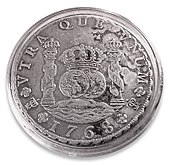Casa de la Moneda
The house Casa de la Moneda ( Spanish mint or money house ), also Casa Real de la Moneda ( Royal Mint or Royal Money House ) in the city of Potosí in Bolivia is a former mint that can now be visited as a museum. The Casa de la Moneda was an important center of the Spanish colonial trade in South America and is now considered one of the most important sights of Potosí.
history
Because of the silver mining on the Cerro Rico mountain and the rapid growth of the Spanish colonial empire in the 16th century, there was a need for a mint in the city. In 1542 the minting business started in a first temporary building. The construction in its current form was suggested by Viceroy Francisco de Toledo and was completed within three years from 1572 under the direction of the architect Jerónimo de Leto near the royal palace in Plaza del Regocijo (today: Plaza 10 de Noviembre). At that time, the Casa de la Moneda was one of the largest building projects in Spain and cost Spain 8,321 pesos and a gold bar. The building is now considered to be one of the most important examples of Spanish colonial architecture in Latin America .
Between 1759 and 1772 the Casa de la Moneda was extended to include an extensive new building facing the nearby Plaza del Gato; However, until its inauguration on July 31, 1773, coin production still took place in the old building. Two years after the founding of the Republic of Bolivia (1825), republican coins were minted in the Casa de la Moneda for the first time in 1827; from 1869 steam engines were used as drives, from 1909 engines. In 1953 the minting of coins was finally stopped after about 400 years.
El Mascaron , the mask over a passage in the inner courtyard of the building, dates from the 19th century . She is interpreted as a representation of the Roman god Bacchus , but often also seen as an indigenous South American who laughs after the Spaniards who have left the country.
During the Chaco War (1932–1935) between Bolivia and Paraguay , the Casa de la Moneda temporarily served as the military headquarters of the Bolivian armed forces.
Today a museum is housed in the building. In addition to religious art, mainly coins and the minting machines once operated by African slaves , as well as the particularly elaborately secured boxes for the transport of the coins to Europe, are exhibited here. In addition, paintings from the colonial and republican times can be viewed, as well as indigenous textiles and exhibits from the time of the Chaco War. The Casa de la Moneda is now considered one of the most important museums in Bolivia and is an important part of the UNESCO World Heritage Potosí.
Type of coinage
The material extracted from the mines was heated until it liquefied and then poured into a metal mold. The mostly angular blank was hit with a hammer . After several days of cooling, this was again slightly heated and cut into smaller blanks with scissors, then the mostly angular ends of the blanks were rolled up towards the center of the coin so that a round shape was obtained. After reheating, the coin was ground into a round shape with a grinding plate. While still heated, the now round coins were printed on both sides with a prefabricated imprint of the holy crown of Spain . This type of coinage was not yet widespread at the time.
literature
- La acuñación de monedas en Potosí , published by the Fundación Cultural del Banco Central de Bolivia, Potosí 2003.
- Hugo Boero Rojo / Luis Alfonso Fernández: La Real Casa de la Moneda Potosí . Los Amigos del Libro, La Paz 1979.
- Arnaldo J. Cunietti-Ferrando: Historia de la Real Casa de Moneda de Potosi durante la dominación hispánica, 1573-1825 , Volume 1: 1573-1652 . Pellegrini, Buenos Aires 1995. (more not yet published)
Individual evidence
- ↑ a b See Polyglott APA Guide South America. Edition 2005/2006 , Langenscheidt Verlag, Berlin / Munich 2004, ISBN 3-8268-1924-1 , here p. 189 f. (On-line)
- ↑ MAQUINARIA DE ACUÑACION DE 1909 on http://www.bolivian.com
- ↑ Jens Glüsing: The Curse of Silver , Spiegel Geschichte 4/2009 .
- ↑ Information on Potosi ( Memento of the original from December 25, 2011 in the Internet Archive ) Info: The archive link was inserted automatically and has not yet been checked. Please check the original and archive link according to the instructions and then remove this notice. on the website of the Bolivian Embassy in Germany (accessed on August 26, 2010)
- ↑ http://whc.unesco.org/en/list/420
Coordinates: 19 ° 35 ′ S , 65 ° 45 ′ W


